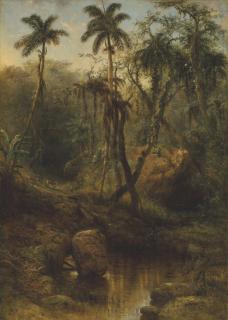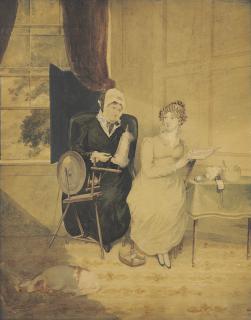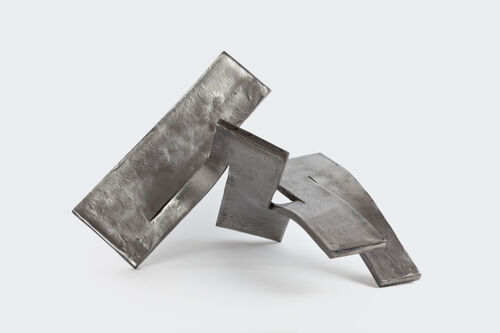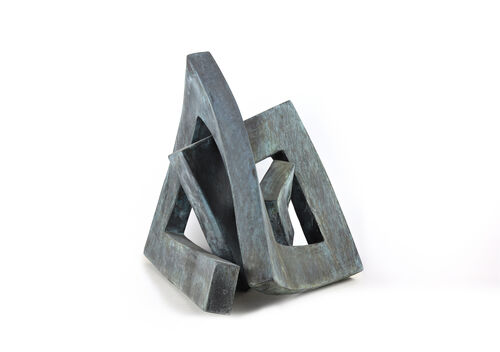William John Huggins
The Hon. Company'S Ship Sir David Scott, At The Entrance Of The Straits Of Sunda, 1831
Found at
Christies,
London (Online Auction)
Topographical Pictures, including China Trade Paintings. ARCTIC · AMERICAS · AFRICA · ASIA · AUSTRALASIA · ANTARCTICA, Lot 62
5. Nov - 5. Nov 2020
Topographical Pictures, including China Trade Paintings. ARCTIC · AMERICAS · AFRICA · ASIA · AUSTRALASIA · ANTARCTICA, Lot 62
5. Nov - 5. Nov 2020
Estimate: 15.000 - 20.000 GBP
Price realised: 17.500 GBP
Price realised: 17.500 GBP
Description
with indistinct inscription 'Mrs Corban(?)' and with National Maritime Museum inventory label on the stretcher
oil on canvas
52 1⁄2 x 68 5⁄8in. (133.3 x 174.3cm.)
Engraved in aquatint by E. Duncan, published by the artist, London, 1833, as 'The H.C.S. Sir David Scott, Captn D. I. Ward, at the entrance of the Straights of Sunda. Febry 1830'.
Huggins paints the East Indiaman furling its Royals and coming to anchor as a Javanese proa (which looks to have borrowed from Thomas and William Daniell's plate 'Malaye Proas' in the Daniells' Picturesque Voyage to India published in 1810) flying a Dutch flag approaches, with monkeys, a cockatoo and caged local fauna to trade with the sailors on board. The Sunda Strait between Java and Sumatra was the passage for virtually all East India trade as it made its way to the Indian Ocean. Its strateg
The Sir David Scott (1342 tons) was one of the largest of the Company's ships, built in the yard of Jabez Bayley at Ipswich for Joseph Hare. She was launched on 21 September 1821 and named for the East India Company director Sir David Scott (1782-1851). She sailed to Bengal and China on her first voyage for the Company in December 1821. The East Indiaman sailed out from the Downs under the command of Captain David James Ward on her fifth voyage to Madras, Bengal and China (as depicted here by Hu
Huggins was in the employ of the East India Company and sailed on voyages to China and India in the early 1800s. Described by the engraver W. J. Linton as ‘a jolly, fat, good-natured fellow, who had been a ship’s cook’ (Memories, 1895, ch.3) he is recorded as a steward and assistant to the purser on the Perseverance which sailed for Bombay and China in 1812, returning in 1814. Soon after, he set up a studio to work on commissions for the Company in Leadenhall Street, near to the East India
Please note this lot is the property of a private individual.
National Maritime Museum, London, acquired c. 1949-51; sale [The Trustees of the National Maritime Museum], Christie’s, South Kensington, 15 May 1997, lot 337.
oil on canvas
52 1⁄2 x 68 5⁄8in. (133.3 x 174.3cm.)
Engraved in aquatint by E. Duncan, published by the artist, London, 1833, as 'The H.C.S. Sir David Scott, Captn D. I. Ward, at the entrance of the Straights of Sunda. Febry 1830'.
Huggins paints the East Indiaman furling its Royals and coming to anchor as a Javanese proa (which looks to have borrowed from Thomas and William Daniell's plate 'Malaye Proas' in the Daniells' Picturesque Voyage to India published in 1810) flying a Dutch flag approaches, with monkeys, a cockatoo and caged local fauna to trade with the sailors on board. The Sunda Strait between Java and Sumatra was the passage for virtually all East India trade as it made its way to the Indian Ocean. Its strateg
The Sir David Scott (1342 tons) was one of the largest of the Company's ships, built in the yard of Jabez Bayley at Ipswich for Joseph Hare. She was launched on 21 September 1821 and named for the East India Company director Sir David Scott (1782-1851). She sailed to Bengal and China on her first voyage for the Company in December 1821. The East Indiaman sailed out from the Downs under the command of Captain David James Ward on her fifth voyage to Madras, Bengal and China (as depicted here by Hu
Huggins was in the employ of the East India Company and sailed on voyages to China and India in the early 1800s. Described by the engraver W. J. Linton as ‘a jolly, fat, good-natured fellow, who had been a ship’s cook’ (Memories, 1895, ch.3) he is recorded as a steward and assistant to the purser on the Perseverance which sailed for Bombay and China in 1812, returning in 1814. Soon after, he set up a studio to work on commissions for the Company in Leadenhall Street, near to the East India
Please note this lot is the property of a private individual.
National Maritime Museum, London, acquired c. 1949-51; sale [The Trustees of the National Maritime Museum], Christie’s, South Kensington, 15 May 1997, lot 337.
Auction result well in line with expectations
The work The Hon. Company'S Ship Sir David Scott, At The Entrance Of The Straits Of Sunda, 1831 by William John Huggins was sold in the Topographical Pictures, including China Trade Paintings. ARCTIC · AMERICAS · AFRICA · ASIA · AUSTRALASIA · ANTARCTICA auction at Christies in London in November 2020. The price achieved of GBP 17,500.00 (€ 19,535.91) was within expectations - the estimate range had previously been set by the auction house as GBP 15,000.00 – 20,000.00. However, buyers have had to dig much deeper into their pockets for other works by William John Huggins - we have observed the highest auction result to date for the work The Opium Ships At Lintin, China, 1824, which sold at auction in April 2011 for GBP 37,250.00 (€ 41,949.92).
Auktionsergebnis im Rahmen der Erwartungen
Die Arbeit The Hon. Company'S Ship Sir David Scott, At The Entrance Of The Straits Of Sunda, 1831 von William John Huggins wurde im November 2020 in der Auktion Topographical Pictures, including China Trade Paintings. ARCTIC · AMERICAS · AFRICA · ASIA · AUSTRALASIA · ANTARCTICA bei Christies in London versteigert. Der dabei erzielte Preis von GBP 17.500,00 (€ 19.535,91) lag im Rahmen der Erwartungen – die Schätzpreisspanne war von dem Auktionshaus zuvor mit GBP 15.000,00 – 20.000,00 angegeben worden. Für andere Arbeiten von William John Huggins mussten die Käufer allerdings auch schon deutlich tiefer in die Tasche greifen – das bisher höchste Auktionsergebnis haben wir für die Arbeit The Opium Ships At Lintin, China, 1824 beobachtet, die im April 2011 für GBP 37.250,00 (€ 41.949,92) versteigert wurde.




















































